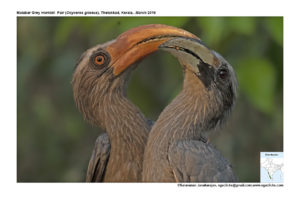Malabar Grey Hornbill

Malabar Grey Hornbill Ocyceros griseus
Etymology:
- Ocyceros : Greek word for pointed horns.
- Griseus : Latin word for Grey
Vernacular Names : Ta: Irattai chondu kuruvi, Mal: Kozhi vezhambal, Kan: Kaldal hakki, Sinh: Kandetta, Hindi: Malabari Dhanesh, Mar: Malabari Rakhi Dhanesh
The hornbills are important large seed dispersers, promoting seedling recruitment by translocating the seeds of the fruits they feed on. Few other bird species outside the hornbill family have large enough gape widths to allow them to disperse large seeds to special microsites or open habitats. Seed dispersal behavior of hornbills thus helps shape forest communities, and disruption of this animal-plant interaction may have significant impacts on the reshaping of forest communities.
Distribution in India: Resident of Western Ghats.
Description: Size: 45 cm. It is a small hornbill with grey, black and white plumage, broad pale eyebrow stripe, rufous vent, and bill with oval nostrils. The male has low casque orange-yellow, bill tip paler; skin around eye and on throat black; eyes red-brown. It has more prominent eyebrow, grey breast, rusty vent, orange bill, black circumorbital skin, oval nostrils. The female is smaller than male, bill paler yellow, blackish patches on smaller casque, black at base of lower mandible.
Habitat: It is found in evergreen and deciduous forest, especially along watercourses and in hill country.
Food Habits: It eats small fruits and berries, especially figs; also eats various insects, lizards, mice and nestlings; sometimes flower petals.
Breeding Habits: They breed between Jan-May in India. They are monogamous and territorial, sometimes engaging in aerial casque-butting. The female hornbill builds a nest in the hollow of a large tree trunk, sealing the opening with a plaster made up mainly of feces. She remains imprisoned there, relying on the male to bring her food, until the chicks are half developed. During this period the female undergoes a complete moult. The young chicks have no feathers and appear very plump. The mother is fed by her mate through a slit in the seal. The clutch consists of one or two eggs, which she incubates for 38–40 days. The female voids feces through the nest slit, as do the chicks from the age of two weeks. Once the female emerges from the nest, the chicks seal it again. The female and chicks are fed in nest by male, regurgitated from gullet. The fledging period is 46 days.